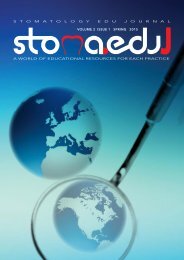Stomatology Edu Journal 1/2014
Create successful ePaper yourself
Turn your PDF publications into a flip-book with our unique Google optimized e-Paper software.
cariology<br />
Cite this article:<br />
Andrian S, Iovan G,<br />
Georgescu A.<br />
Remineralisation<br />
of affected dentine by<br />
different bioactive<br />
materials in the stepwise<br />
excavation tehnique.<br />
Stoma <strong>Edu</strong> J. <strong>2014</strong>;<br />
1(1):12-17.<br />
REMINERALISATION OF AFFECTED<br />
DENTINE BY DIFFERENT BIOACTIVE<br />
MATERIALS IN THE STEPWISE<br />
EXCAVATION TECHNIQUE<br />
https://doi.org/10.25241/stomaeduj.<strong>2014</strong>.1(1).art.2<br />
Sorin Andrian a *,<br />
Gianina Iovan b ,<br />
Simona Stoleriu c ,<br />
Claudiu Topoliceanu d ,<br />
Andrei Georgescu e<br />
Department of Odontology, Periodontology<br />
and Fixed Prosthodontics, Faculty of Dental<br />
Medicine, „Gr.T.Popa” University of Medicine<br />
and Pharmacy, Jassy, Romania<br />
a. DDS, PhD, Professor<br />
b. DDS, PhD, Associate Professor<br />
c. DDS, PhD, Lecturer<br />
d. DDS, PhD student, Assistant Professor<br />
e. DDS, PhD, Assistant Professor<br />
Abstract<br />
Introduction. The aim of this study was to assess dentine remineralisation<br />
and the possibility to maintain the pulp vitality using several bioactive<br />
materials applied in the „stepwise” excavation technique after the carious<br />
dentine was removed using the CarisolvTM system (Sävedalen, Sweden).<br />
Methodology. The study was performed on 25 patients with a high caries<br />
risk, between 18-34 years old. 30 posterior teeth with acute dental caries<br />
were treated using the „stepwise” excavation technique. The patients were<br />
divided in three study groups, according to the type of bioactive materials:<br />
group 1 (10 acute dental caries) - Ca(OH) 2 liner (Dycal, DeTreyDentsply)<br />
and zinc-oxyde-eugenol (Caryosan, Spofa Dental); group 2 (10 acute dental<br />
caries) - zinc-oxyde-eugenol (Caryosan, Spofa Dental); group 3 (10 acute<br />
dental caries) - Ca(OH) 2 liner (Dycal, DeTreyDentsply) and glassionomer<br />
cement (Ketac Molar Easymix, 3M ESPE). After 6 months the changes<br />
of color and consistency of dentine were assessed using both clinical<br />
examination and radiographs, and pulp vitality was tested.<br />
Results. In study group 1, the dental vitality was maintained in 100% percent<br />
of the cases. In study group 2, a case of chronic pulpitis was recorded. In this<br />
study group, the dental vitality was maintained in 90% cases. In study group<br />
3 a case of pulp necrosis associated with a periapical lesion was recorded.<br />
This study group also presented therapeutical success in 90% cases.<br />
Conclusion. The „stepwise” technique used after the removal of infected<br />
dentine with the CarysolvTM system provided remineralisation of affected<br />
dentine in 70-80% percent of the patients and maintained the pulp vitality in<br />
90%-100% cases.<br />
Key words: acute dental caries, „stepwise” excavation technique,<br />
CarisolvTM, remineralisation, dentine.<br />
Received: 27 November 2013<br />
Accepted: 11 December 2013<br />
*Corresponding author:<br />
Professor Sorin Andrian, DDS, PhD<br />
Department of Odontology, Periodontology and<br />
Fixed Prosthodontics,<br />
Faculty of Dental Medicine, „Gr.T.Popa” University of<br />
Medicine and Pharmacy, Jassy, Romania<br />
16 Universitatii Str., RO-700115, Jassy, Romania.<br />
Tel/Fax: +40232301618<br />
e-mail: sorinandrian@yahoo.com<br />
Introduction<br />
Acute dental caries, characterized by deep demineralization and high risk of pulp involvement,<br />
require a progressive therapeutical approach more adequate in maintaining pulp vitality. The<br />
therapy of acute dental caries, using the „stepwise” excavation technique, requires the monitoring<br />
of pulp-dentine response to the materials applied for pulp capping. The traditional evaluation<br />
uses clinical examination, recording of the changes of dentine color and consistency during<br />
therapy. The neodentinogenesis and remineralisation reactions represent an important part<br />
of the pulp-dentin protection system, blocking the invasion of bacteria and their co-products.<br />
There are two layers of altered dentine with different characteristics: the layer of infected<br />
dentine which is heavily contaminated and the layer of affected dentine with a lower degree<br />
of bacterial contamination. The infected dentine is soft and yellow and it is characterized by<br />
extensive breakdown of the organic matrix. This layer should be removed as its remineralisation<br />
potential is lost. The affected layer consists of dentine with medium consistency and some<br />
degree of elasticity. In many cases of acute dental caries it is difficult to clearly differentiate<br />
the limit between the two layers. Since most of the recent data recommend the maintenance<br />
12 Stoma.eduJ (<strong>2014</strong>) 1 (1)




